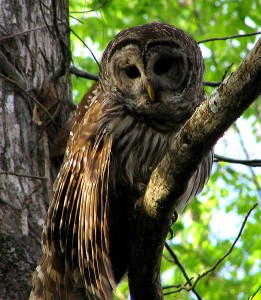“Who Cooks for You?”
Has anyone ever asked you this question? Chances are, probably not, but I would be willing to bet you have heard something that sounds like, “Who cooks for you? Who cooks for you all?” from our wild neighbor, the Barred Owl. Take a listen for yourself and see if you can hear the phrase in its call.
December is courting time for these majestic, silent flyers. Courting calls between birds can be quite loud, even waking people out of a deep sleep. The vocalizations of the Barred Owl have been used to identify the species in the forest. Males use two different calls. One call sounds like a deep barking call in which the bird will increase the volume of the call, and then end it with a powerful hoot. This call is believed to be a signal of aggression by the owl. The second call is used by the owl to state its territory and to attract mates. This call has a more rhythmic sound or pattern, much like the phrase “Who cooks for you, who cooks for you all?”
Background
 Barred Owls are found across the eastern half of the United States, and in Florida, the Barred Owl is a resident species, meaning it does not migrate. Although many species of owls are strictly nocturnal, the Barred Owl is sometimes active during the day.
Barred Owls are found across the eastern half of the United States, and in Florida, the Barred Owl is a resident species, meaning it does not migrate. Although many species of owls are strictly nocturnal, the Barred Owl is sometimes active during the day.
These birds can be found making their home in mature trees of woodlands and swamps. Most of the trees used for nesting are deciduous, meaning they lose their leaves in the fall. Barred Owl nests are usually situated in cavities in naturally hollowed trees and snags (dead standing trees), but can sometimes be found in old nests of hawks, crows, and squirrels.
An open understory with sparse vegetation below the main tree canopy is necessary for the owl to perch on branches and be able to see and fly below to catch their prey. The availability of these perch sites has been found to be an important factor in habitat selection. The most widely eaten prey are small mammals, such as short-tailed shrews, white-footed mice, rats and voles. If the prey is small enough, the bird may swallow it whole and will later regurgitate pellets consisting of the indigestible parts, such as bones and fur.
Cool Facts
- The Barred Owl is named for the feather patterns, which are barred with the alternating colors of white and brown, located on its head, chest and back.
- Whenever possible, the owls will usually occupy the same nest site every year.
What You Can Do to Help
The Barred Owl is in need of mature trees for nesting if it is to maintain stable population levels. For the conservation of the species, it is important to protect and manage the older trees in the upland woods and wetland areas.
Sources:
http://edis.ifas.ufl.edu/uw167
http://en.wikipedia.org/wiki/File:Hontoon_Dead_-_Barred_Owl.jpg (Photo)
 0
0
